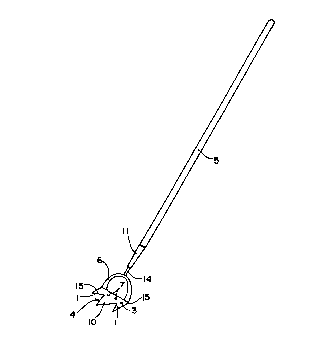Une partie des informations de ce site Web a été fournie par des sources externes. Le gouvernement du Canada n'assume aucune responsabilité concernant la précision, l'actualité ou la fiabilité des informations fournies par les sources externes. Les utilisateurs qui désirent employer cette information devraient consulter directement la source des informations. Le contenu fourni par les sources externes n'est pas assujetti aux exigences sur les langues officielles, la protection des renseignements personnels et l'accessibilité.
L'apparition de différences dans le texte et l'image des Revendications et de l'Abrégé dépend du moment auquel le document est publié. Les textes des Revendications et de l'Abrégé sont affichés :
| (12) Brevet: | (11) CA 2180037 |
|---|---|
| (54) Titre français: | INSTRUMENT ARATOIRE |
| (54) Titre anglais: | CULTIVATING TOOL |
| Statut: | Périmé et au-delà du délai pour l’annulation |
| (51) Classification internationale des brevets (CIB): |
|
|---|---|
| (72) Inventeurs : |
|
| (73) Titulaires : |
|
| (71) Demandeurs : |
|
| (74) Agent: | |
| (74) Co-agent: | |
| (45) Délivré: | 1998-06-16 |
| (22) Date de dépôt: | 1996-06-27 |
| (41) Mise à la disponibilité du public: | 1996-12-28 |
| Requête d'examen: | 1996-06-27 |
| Licence disponible: | Oui |
| Cédé au domaine public: | S.O. |
| (25) Langue des documents déposés: | Anglais |
| Traité de coopération en matière de brevets (PCT): | Non |
|---|
| (30) Données de priorité de la demande: | S.O. |
|---|
Outil manuel pour cultiver la terre, comprenant un manche allongé, une lame, dont le bord de coupe avant présente des dents acérées, montée sur le manche de sorte qu'elle puisse être enfoncée dans la terre pour en extirper la végétation non désirée. La lame présente habituellement une dent coupante centrale en sa partie la plus avant et deux dents coupantes latérales, une de chaque côté de la dent centrale, portant une encoche en V sur le bord en face de la dent centrale pour la coupe sélective. Une dent ouvreuse réglable peut être montée sur la lame.
A manually operable tool for cultivating the surface of the earth,
the tool including an elongate handle, a blade including a sharp
toothed forward cutting edge mounted on the handle so that the blade
may be pushed through the earths surface for the eradication of
unwanted vegetation, the blade normally has a centrally located most
forwardly formed cutting tooth and a side tooth disposed on each side
of the most forwardly formed tooth, each of the side teeth include a
"V" notch on an edge facing the centrally located cutting tooth for
selective severing, the blade further provides for the mounting of
an adjustable furrow tooth.
Note : Les revendications sont présentées dans la langue officielle dans laquelle elles ont été soumises.
Note : Les descriptions sont présentées dans la langue officielle dans laquelle elles ont été soumises.

2024-08-01 : Dans le cadre de la transition vers les Brevets de nouvelle génération (BNG), la base de données sur les brevets canadiens (BDBC) contient désormais un Historique d'événement plus détaillé, qui reproduit le Journal des événements de notre nouvelle solution interne.
Veuillez noter que les événements débutant par « Inactive : » se réfèrent à des événements qui ne sont plus utilisés dans notre nouvelle solution interne.
Pour une meilleure compréhension de l'état de la demande ou brevet qui figure sur cette page, la rubrique Mise en garde , et les descriptions de Brevet , Historique d'événement , Taxes périodiques et Historique des paiements devraient être consultées.
| Description | Date |
|---|---|
| Le délai pour l'annulation est expiré | 2005-06-27 |
| Inactive : Demande ad hoc documentée | 2005-03-31 |
| Lettre envoyée | 2004-06-28 |
| Inactive : Correspondance - Taxe finale | 1999-06-02 |
| Accordé par délivrance | 1998-06-16 |
| Inactive : Taxe finale reçue | 1998-01-20 |
| Préoctroi | 1998-01-20 |
| Lettre envoyée | 1997-12-16 |
| Un avis d'acceptation est envoyé | 1997-12-16 |
| Un avis d'acceptation est envoyé | 1997-12-16 |
| Inactive : Renseign. sur l'état - Complets dès date d'ent. journ. | 1997-12-08 |
| Inactive : Dem. traitée sur TS dès date d'ent. journal | 1997-12-08 |
| Inactive : Approuvée aux fins d'acceptation (AFA) | 1997-11-18 |
| Demande publiée (accessible au public) | 1996-12-28 |
| Toutes les exigences pour l'examen - jugée conforme | 1996-06-27 |
| Exigences pour une requête d'examen - jugée conforme | 1996-06-27 |
Il n'y a pas d'historique d'abandonnement
Le dernier paiement a été reçu le 1998-05-27
Avis : Si le paiement en totalité n'a pas été reçu au plus tard à la date indiquée, une taxe supplémentaire peut être imposée, soit une des taxes suivantes :
Les taxes sur les brevets sont ajustées au 1er janvier de chaque année. Les montants ci-dessus sont les montants actuels s'ils sont reçus au plus tard le 31 décembre de l'année en cours.
Veuillez vous référer à la page web des
taxes sur les brevets
de l'OPIC pour voir tous les montants actuels des taxes.
| Type de taxes | Anniversaire | Échéance | Date payée |
|---|---|---|---|
| Taxe finale - petite | 1998-01-20 | ||
| TM (demande, 2e anniv.) - petite | 02 | 1998-06-29 | 1998-05-27 |
| TM (brevet, 3e anniv.) - petite | 1999-06-28 | 1999-04-20 | |
| TM (brevet, 4e anniv.) - petite | 2000-06-27 | 2000-04-25 | |
| TM (brevet, 5e anniv.) - petite | 2001-06-27 | 2001-06-01 | |
| TM (brevet, 6e anniv.) - petite | 2002-06-27 | 2002-06-27 | |
| TM (brevet, 7e anniv.) - petite | 2003-06-27 | 2003-04-11 |
Les titulaires actuels et antérieures au dossier sont affichés en ordre alphabétique.
| Titulaires actuels au dossier |
|---|
| GARNET L. GILLESPIE |
| Titulaires antérieures au dossier |
|---|
| S.O. |